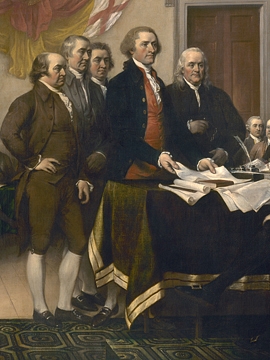Making of the U.S. Constitution
Beginning in 1775, the American colonists stepped up their defiance against the authority of Parliament and King George with increasing acts of civil disobedience and street protests. That defiance quickly evolved into outright rebellion and war. By the time the Second Continental Congress convened in Philadelphia on May 10, 1775, a violent revolution was already underway. While more reluctant delegates dragged their heels-- still hoping to reconcile with Mother England-- others pushed for independence. The Congress officially declared independence in 1776 and approved the Articles of Confederation in 1781. That was followed up by the United States Constitution in 1789.
1775
On June 14 the Second Continental Congress established the Continental Army, originally comprised of a number of militia groups near Boston. George Washington-- who'd shown up at the Congress wearing his military uniform as an indication of his eagerness to serve-- was appointed Major General and Commander-in-Chief.
1775
Hoping to avert a disastrous war that America was not likely to win, the delegates to the Congress sent an historic "Olive Branch Petition" to King George, affirming their loyalty to England. But before the Petition even arrived, the King issued his "Proclamation for Suppressing Rebellion and Sedition" in which he made clear his intention to use military force to put down the American revolution and demonstrate his authority over the colonies.
1776
On January 10, an underwear salesman-turned-journalist released what would prove to be one of the most influential books in American history. The little 48-page pamphlet argued with passionate conviction for American independence and urged colonists to join the right for liberty and freedom. It quickly became one of the most read and talked about books of its time-- and is to this day reported to be the best-selling book in U.S. history (when factored for population). Out of concern he would be arrested and put to death for treason, the author did not put his name to the book. It said simply, "Written by an Englishman." This little book helped to change the course of American history. Who was the Englishman and what was the name of his book?
1776
On July 2 the Second Continental Congress voted to dissolve any ties that America had to Great Britain and to declare independence. Two days later, on July 4, a final draft of a Declaration of Independence was approved.
1777
On November 15 a final draft of the Articles of Confederation was approved by the delegates to the Second Continental Congress. This proved to be America's first attempt at a written constitution and would serve as the unifying document for the American states until the U.S. Constitution was adopted in 1789. The Articles of Confederation were fully ratified by all thirteen states in the March of 1781.
1781
Thanks to the aid of the French fleet, the British surrendered at Yorktown, Virginia on October 19. The Treaty of Paris was signed two years later (September 3), effectively ending the American Revolution.
1787
After a few years of struggling under the ineffectual and often useless tenets of the Articles of Confederation, congressional leaders gathered in Philadelphia for the specific task of rewriting that agreement. But some delegates to the convention, which met from May through September, aimed to create an altogether new constitution that could better unite the various states into a stronger and more potent union. The result was the United States Constitution, which was approved by the convention that fall and sent to the states for ratification.
1787
Beginning just a few weeks after the Philadelphia Convention ended, and running through August of the following summer, 1788, a series of 85 essays appeared in three New York newspapers, arguing in support of the new U.S. Constitution. The essays were published anonymously under the pseudonym "Publius" but are believed now to have been written by Alexander Hamilton, James Madison and John Jay. The essays were published collectively in 1788 as "The Federalist" and beginning in the 20th century became known as "The Federalist Papers."
1788
By the end of the summer of 1788 all but two states (North Carolina and Rhode Island) had voted to ratify the Constitution. The first Congress convened under the new U.S. Constitution in the spring of 1789 in the nation's first capital city, New York. On April 21, 1789 George Washington was selected as the country's first president on and was sworn into office that very day.
1789
Congressman James Madison of Virginia, who'd helped to oversee the drafting of the new Constitution at the Philadelphia Convention, introduced an enumerated Bill of Rights to the First Congress. Following ratification by three-fourths of the states, this Bill of Rights went into effect in December 1791.


